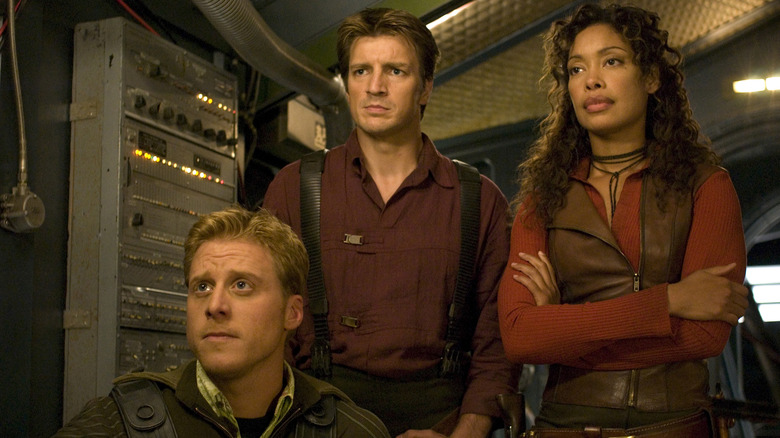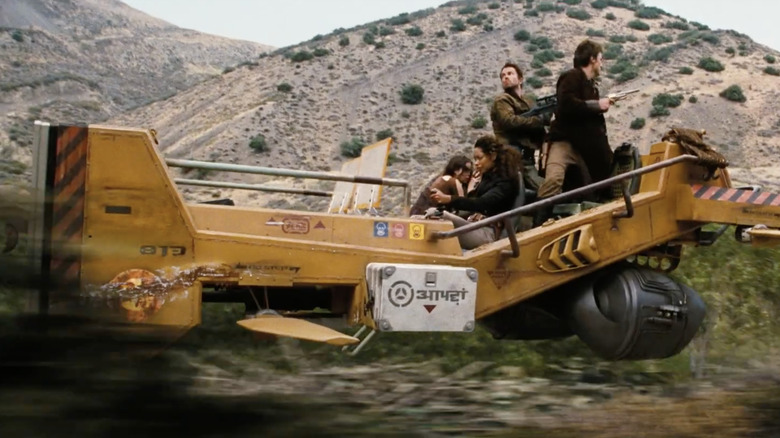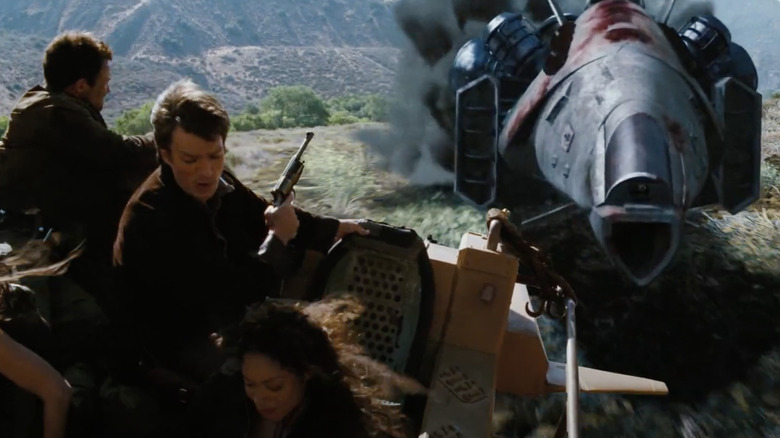Serenity's Small Budget Meant Finding A Way To Make A Hovercraft 'Fly'
"Firefly" was one of those shows I'd sometimes stumble upon late at night — like "Stargate: SG-1" over on the SyFy channel or "Silverhawks" — that really stirred up my love for space operas/westerns. I never did sit down to watch the show in order — at the time I was beholden to whatever episodes were being aired, although I did end up catching multiple viewings of "Serenity." Back then I had no idea that "Firefly" had barely lasted a season on air before being canceled in 2002, or that the film was Joss Whedon's last-ditch effort to keep the series alive in some form.
Eventually, Universal acquired the rights from Fox but refused to approve the over $100 million budget that was estimated to make it, recommending the production move overseas. But Whedon managed to convince them they could make it locally and under budget — which was set at $40 million. To put that into perspective, the prequel "Attack of the Clones" had a budget of $115 million.
When production finally finished and the dust settled, "Serenity" was completed for a staggeringly low dollar amount for a sci-fi film, costing Universal only $39 million to make. So how did they pull off the kind of special effects you see in the film on such a remarkably small budget? A ton of ingenuity and as many practical effects as they could get away with.
Building a hovercraft from the ground up
In a lot of ways, the anecdote of a low-budget catalyzing special effects genius is a timeless one in Hollywood. The spirit of the early days of digital effects played out on "Serenity" in much the same way. One of the scenes that presented a major hurdle was the hovercraft chase scene in which the eponymous ship's crew is chased by animalistic Reavers. "On a big budget feature we'd use a lot of green screen and digital doubles, but we didn't have that kind of money on this movie," visual effects supervisor and second unit director Loni Peristere told HowStuffWorks.com. Which meant they had to get really creative.
The goal was to make the sequence feel "contemporary, interesting, and fast-paced" without having to enhance every part of it with digital effects. So to that end, Peristere had a rig built that would hold up the hovercraft 15 feet alongside a towing vehicle. Placing it on two "giant steel arms" they were able to tow the entire craft safely at speeds of 45 miles an hour — which went a long way in creating the rather convincing illusion that it was indeed hovering.
In order to photograph the sequence, Peristere couldn't rely on the use of a gimbal — which is what was used for the podrace scene in "The Phantom Menace." Instead, they used a much cheaper plan that involved placing cameras onto the towing rig and a car following behind. All of it makes for a bumpy and chaotic ride, but the actors did seem to enjoy it. Adam Baldwin, whose character gets harpooned and ends up hanging off the hovercraft before being pulled back in by Nathan Fillion's character, said it was "the most fun I've had working in my entire life."
The benefits of frugality
Rewatching the chase scene from "Serenity," you can tell there are selective crops being made to hide the extent of the whole rig — set dressers even used trees and shrubs to help hide the practical effects. While the extensive rigging Peristere had made is nonexistent and all the evidence of their creativity is rather elegantly scrubbed clean in post-production. Although even then they had to be pretty frugal about what they edited and how they planned to do it.
"We had to match and replace the road and terrain and the rest of the world that you see when you widen the lens," Peristere explained. "We took detailed measurements of the road and replaced that road with a computer-generated terrain system that used elements from the scene to mimic what was on the screen." They even photographed plants to create 3-D renderings that they could then import onto their computer-generated terrain.
And for the Reaver ship that pursues them, only a little CGI was used to enhance what was essentially just an old truck that set special effects director Daniel Sudick acquired and ripped up to use for close-ups. "It also gave us a physical model on location and an eye line for the actors," Peristere told the Los Angeles Times. "It was very inexpensive, and it provided a lot of value." But even two decades later, the sequence absolutely holds up to even modern CGI and practical effects magic.


